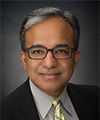Hepatology
Liver Fibrosis
Multidisciplinary Care for Nonalcoholic Fatty Liver Disease
Overview
Given the prevalence and clinical significance of nonalcoholic fatty liver disease (NAFLD), there is a growing call for multidisciplinary care. Opportunities for improving the identification of patients at risk for significant liver disease were highlighted in several presentations at The Liver Meeting® 2021.
Following the conference, featured expert Kris V. Kowdley, MD, FACP, FACG, AGAF, FAASLD, was interviewed by Conference Reporter Editor-in-Chief Tom Iarocci, MD. Dr Kowdley’s clinical perspectives on this topic are presented here.
Kris V. Kowdley, MD, FACP, FACG, AGAF, FAASLD
|
|
“Given the need for multidisciplinary care in NAFLD, it is critical that we partner with our colleagues.”
NAFLD is a worldwide clinical problem. In the United States, we estimate that 1 of 3 people are affected, but rates vary globally. Additionally, a genetic component has been implicated in the development of the disease. For example, differences in the severity and progression of NAFLD that occur between individual patients and between patients of various ethnicities suggest the involvement of genetic factors, and NAFLD has been associated with variants in genes such as PNPLA3 and TM6SF2.
In addition to its global prevalence, NAFLD is a multisystem disease. Insulin resistance is a central feature in its development, along with systemic abnormalities such as type 2 diabetes, hypertension, and hyperlipidemia. Of course, weight gain and obesity are key factors in the development of NAFLD, and obesity is also common in patients with nonalcoholic steatohepatitis (NASH). In fact, Younossi reported at The Liver Meeting that approximately 80% of the population with NASH has obesity (abstract LO4). In addition to cardiovascular disease and stroke, obesity-associated comorbidities such as sleep apnea and, potentially, chronic kidney disease are therefore also very relevant. Only a minority of patients with NAFLD will go on to develop NASH, but in those who do, progression to stage 2 and especially stages 3 and 4 fibrosis (stage 4 is cirrhosis) is associated with higher rates of complications of liver disease, hepatocellular carcinoma, and all-cause mortality.
Given the need for multidisciplinary care in NAFLD, it is critical that we partner with our colleagues. If we do not, especially at the level of primary care, we are not going to have the ability to identify patients at a stage that is treatable. Moreover, patients with NASH are often asymptomatic, and when they do present for medical attention, they may encounter different silos in the medical system, with varying approaches by specialty.
We presented a poster abstract at The Liver Meeting 2021 on current challenges faced by hepatologists and endocrinologists in caring for patients with NASH (abstract 649); we found that 48% of hepatologists and 23% of endocrinologists reported suboptimal skills in managing cardiovascular risk. In addition, more endocrinologists than hepatologists reported suboptimal knowledge in determining follow-up frequency, and endocrinologists reported suboptimal skills in quantifying fibrosis (78%) and in estimating hepatocellular carcinoma risk (74%). These are important findings that relate to the ability to identify patients who should receive screening, further referral, or treatment.
Our understanding of NAFLD has been developing rather rapidly, and, as such, the story of the 5 blind men and the elephant comes to mind regarding the roles of different practitioners. The cardiologist is focused on the trunk because that is where the coronary arteries are, as well as on lipoproteins, possibly the subfractionation of the lipoprotein particles, and the blood pressure. The endocrinologist is focused on hemoglobin A1c and perhaps on weight. The hepatologist or gastroenterologist is looking at the liver enzymes and is focused on the liver. It is important, however, that we are all thinking about NAFLD, whether it is the cardiologist who is seeing a patient initially when liver disease may not be apparent, the endocrinologist who is focused on the hemoglobin A1c and may incidentally notice an echogenic liver on ultrasound, or the primary care doctor whose patient with obesity has mildly elevated liver enzymes that might be attributable to statin use.
We currently have interventions that work, and more will be emerging in the future. Weight loss can reverse fibrosis in NASH. Contemporary practice guidelines state that a 5% to 10% weight loss through lifestyle changes or bariatric surgery is the treatment of choice to prevent NAFLD progression in patients with obesity. Having a dedicated weight intervention pathway may be particularly effective (abstract 29). Moreover, among individuals with obesity who have already developed NASH, bariatric surgery has been linked to a significantly lower risk of incident major adverse liver outcomes and major adverse cardiovascular events.
Similarly, diabetes control is needed to not only reduce hemoglobin A1c but also to manage NASH associated with diabetes. Glucagon-like peptide-1 analogues are now approved by the US Food and Drug Administration for weight loss, in addition to diabetes, and these agents have some of the highest rates of NASH resolution associated with treatment that we have with any pharmacotherapy currently being developed for NASH. Whether these agents will reverse fibrosis or halt progression to cirrhosis remains to be determined, but it is quite clear that pharmacologic approaches to managing diabetes could have other effects in terms of NASH and FLD.
In conclusion, each practitioner should think of NAFLD not in isolation, but as being integral to the metabolic syndrome, understanding that patients with more advanced forms of the disease also have a higher risk of morbidity and mortality. Identifying those individuals who are at greater risk or who already have advanced fibrosis should be something that we all incorporate as part of our assessment.
References
Aminian A, Al-Kurd A, Wilson R, et al. Association of bariatric surgery with major adverse liver and cardiovascular outcomes in patients with biopsy-proven nonalcoholic steatohepatitis. JAMA. 2021;326(20):2031-2042. doi:10.1001/jama.2021.19569
Byrne CD, Targher G. NAFLD as a driver of chronic kidney disease. J Hepatol. 2020;72(4):785-801. doi:10.1016/j.jhep.2020.01.013
Choudhary NS, Duseja A. Genetic and epigenetic disease modifiers: non-alcoholic fatty liver disease (NAFLD) and alcoholic liver disease (ALD). Transl Gastroenterol Hepatol. 2021;6:2. doi:10.21037/tgh.2019.09.06
Dulai PS, Singh S, Patel J, et al. Increased risk of mortality by fibrosis stage in nonalcoholic fatty liver disease: systematic review and meta-analysis. Hepatology. 2017;65(5):1557-1565. doi:10.1002/hep.29085
Kasper P, Martin A, Lang S, et al. NAFLD and cardiovascular diseases: a clinical review. Clin Res Cardiol. 2021;110(7):921-937. doi:10.1007/s00392-020-01709-7
Kowdley KV, Murray S, Lazure P, et al. Monitoring and management of NASH is an unmet need among hepatologists and endocrinologists: an international mixed-method study in Europe and the USA [abstract 649]. Abstract presented at: AASLD The Liver Meeting; November 12-15, 2021.
Lassailly G, Caiazzo R, Ntandja-Wandji LC, et al. Bariatric surgery provides long-term resolution of nonalcoholic steatohepatitis and regression of fibrosis. Gastroenterology. 2020;159(4):1290-1301.e5. doi:10.1053/j.gastro.2020.06.006
Moolla A, Motohashi K, Marjot T, et al. A multidisciplinary approach to the management of NAFLD is associated with improvement in markers of liver and cardio-metabolic health. Frontline Gastroenterol. 2019;10(4):337-346. doi:10.1136/flgastro-2018-101155
Ponziani FR, Gasbarrini A, Pompili M. NAFLD or comorbidities, that is the question. J Hepatol. 2020;73(3):723. doi:10.1016/j.jhep.2020.04.026
Ruissen MM, Mak AL, Beuers U, Tushuizen ME, Holleboom AG. Non-alcoholic fatty liver disease: a multidisciplinary approach towards a cardiometabolic liver disease. Eur J Endocrinol. 2020;183(3):R57-R73. doi:10.1530/EJE-20-0065
Shah V, Repking S, Folkers C, Fetrow LC, Janardhan S, Reau N. An advanced practice provider (APP) pathway achieves more effective weight loss in NAFLD patients compared to standard of care [abstract 29]. Abstract presented at: AASLD The Liver Meeting; November 12-15, 2021.
Younossi ZM, Paik JM, Henry L, et al. Burden of illness and economic impact of nonalcoholic steatohepatitis (NASH) in the United States according to the presence of obesity [abstract LO4]. Abstract presented at: AASLD The Liver Meeting; November 12-15, 2021.
This information is brought to you by Engage Health Media and is not sponsored, endorsed, or accredited by the American Association for the Study of Liver Diseases.











